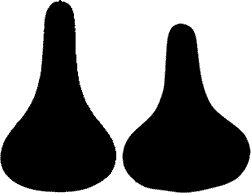Increasing Cycling Comfort... Bicycle Saddles
The choice of saddle is an extremely personal one. But it is a choice that you will either love or loathe whilst ever it is in use.
There are only three points of contact between you and your bike. Your feet press on the pedals, your hands rest on the handlebars and your bum perches on your saddle!
Of these three interfaces, the saddle is by far the one which gives rise to the most complaints of discomfort. But why?
It's all to do with your posterior! Believe it or not, we're all different down there. The amount of fatty tissue, amount of muscle tissue, the specific geometry of our pelvis, it's all unique and so what is comfortable to one person can be excruciatingly painful to another. BUT the answer is at hand. Saddles are available in a multitude of shapes and sizes and made from a variety of materials and with different levels of padding. We've separated them into groups to explain each of the different aspects.
All saddles consist of one common feature; the cradle. This is generally steel although many racing saddles have cradles constructed from lighter weight materials like titanium, carbon fibre and magnesium but in essence, virtually all saddles have a cradle which allows it to be fastened to the seat pillar.
There are only three points of contact between you and your bike. Your feet press on the pedals, your hands rest on the handlebars and your bum perches on your saddle!
Of these three interfaces, the saddle is by far the one which gives rise to the most complaints of discomfort. But why?
It's all to do with your posterior! Believe it or not, we're all different down there. The amount of fatty tissue, amount of muscle tissue, the specific geometry of our pelvis, it's all unique and so what is comfortable to one person can be excruciatingly painful to another. BUT the answer is at hand. Saddles are available in a multitude of shapes and sizes and made from a variety of materials and with different levels of padding. We've separated them into groups to explain each of the different aspects.
All saddles consist of one common feature; the cradle. This is generally steel although many racing saddles have cradles constructed from lighter weight materials like titanium, carbon fibre and magnesium but in essence, virtually all saddles have a cradle which allows it to be fastened to the seat pillar.
Material Constructions:
Solid Leather.
The very first bicycle saddles made were of thick leather suspended across the cradle. Initially the leather is extremely hard but with correct maintenance (a proofing material) the leather eases and gradually adapts itself to your particular shape. This process is not quick though but in the long term, a leather saddle will perfectly mould itself to the contours of your behind. Solid leather saddles last for years, far outlasting most other types if maintained correctly but the downside is the wearing in period. It is a good choice for higher mileage cyclists, just don't be tempted to lend your saddle to someone else because it won't be right for them.
"Leatherette" Coated or Plain Solid Plastic.
This is perhaps the most crude form of bicycle saddle commonly fitted to cheaper bikes. There may be a small amount of foam padding between the leatherette and the plastic base. Whilst OK for short distance rides this is unlikely to make you feel comfortable for periods greater than 10-15 minutes.
Mattress Saddles.
These were commonly fitted to the typical "shopper" type bikes popular a number of years ago. They were also extremely common on many many bikes through the middle of the last century. These were cheaper to manufacture than solid leather saddles and as such took over as the main saddle type for everyday bikes prior to the introduction of moulded plastics. The mattress saddle consists of a metal frame with springs slung from front to back. These springs allowed the covering (commonly vinyls) to give a little under pressure. The introduction of moulded plastics saw a decrease in mattress saddles, however some modern saddle designs now are using the mattress principles.
Sprung Saddles.
These were extremely common on bikes where the seated position was a little more upright to reduce jarring in the lower back. Sometimes coupled to a mattress type frame, a sprung saddle has 2 coil springs supporting the back of the saddle onto the cradle, with a pivot point at the front. More elaborate ones also have a third spring at the front. They certainly absorb quite an amount of road vibration but the downside is that the saddle can feel a little bouncy and move from side to side. Whilst ok for slower speeds, this bounciness can be a nuisance at higher speeds.
Gel & Gelfoam Saddles.
Modern materials throw up all sorts of possibilities and one material which has had perhaps the biggest impact on bicycle saddle design in the past 25 years is the introduction of "Gel". A true gel saddle has an insert of a viscous material (the gel) housed between a moulded plastic base and the covering material, commonly lycra, leatherette (vinyl) or leather. Similar to the inserts used in a particular type of cosmetic surgery, the gel insert will mould itself to the shape anything pressed against it, in this case your behind. The gel itself is not liquid but similar in texture to jelly. Owing to the viscous nature of the material, it can move with you acting as a cushion between you and the solid base material below. "Gelfoam" is not the same as Gel. Gelfoam is not viscous, it is simply an absorbent foam type material which has a pliable feel. When pressure is released from gelfoam, it immediately springs back into shape, whereas a true gel will almost appear to flow back into its original shape. The primary difference between gel and gelfoam is that a true gel has a fixed volume, there is no reduction in volume under compression, the gel simply relocates to an area of lesser compression. This in turn means that it provides a better level of comfort. A gelfoam filling will compress at the points where pressure is applied, reducing its volume and increasing the relative density at the pressure points. A true gel saddle will offer greater comfort than a gelfoam saddle. As Gel and Gelfoam are fillings, they can be inserted into any of the three preceding saddle types.
Saddle features:
Hole Saddles.
Hotly debated is the relative merits of, or lack of merit, for saddles which feature holes in strategic locations. The claimed benefit is a reduction in localised pressure on the genitalia. Some reports suggest that the hole is a bad idea whereas others claim it is a good one. We're not here to judge either way! It is however true that a large number of riders find that a saddle with a hole is far more comfortable than one without.
Pressure Point Gel Inserts.
These saddles are similar to those above but rather than leave an open hole through the saddle, the cavity is filled with a gel insert which will still provide support throughout the genital region but without creating excess pressure.
Raised Pelvic Seats.
The majority of your weight is carried through your pelvic bone which has 2 protrusions immediately below the thigh joints. Many saddles feature raised sections with extra padding at the point where the two pressure points are at their greatest.
Narrow vs. Wide.
Many non-regular cyclists look at narrow saddles and imagine them to be extremely uncomfortable. Just remember that old Yellow Pages advert! However most distance riders, whether racing or touring, find that a narrow saddle is far more comfortable over distance than a wide one. A narrow saddle does not interfere with your pedalling and allows you to move forward and backwards to move the points of pressure. Wider saddles tend to fix you in position and that is where you stay. But as comfort is psychological and not just physical, wider saddles will remain comfortable to a huge number of people. Try one for a longer ride and you might just be surprised though!
Ladies Specific Saddles.

The majority of a riders weight is transferred through the lower section of the pelvis (Inferior pubic ramus) the two sides of which are further apart within the female pelvis than in the male.
Lady specific saddles take this difference in bone structure into account and are generally modestly wider at the back, are shorter from nose to back and have far more pronounced cutaways at the sides to accommodate the thighs. Unfortunately, however, most off the peg bikes come fitted with a mans saddle, which can be very uncomfortable for lady riders.
Choosing.
Saddle choice is very personal. We cannot say that you should buy any particular type of saddle, nor one which has any specific features.
Ideally, you should try them for yourself. Better quality bicycle shops will be more than willing to allow you to sit on a few different saddles prior to making a selection and we would recommend that you do so.
Most decent bike shops will allow you to upgrade the saddles fitted to new bikes at the point of purchase. Expect to pay the relevant price difference BUT this is one upgrade well worth considering. Many, many bikes come fitted with saddles which are not particularly comfortable even though they look comfortable. Ultimately, a quality comfortable saddle is not a cheap item but should serve you well in comfort terms.
Ideally, you should try them for yourself. Better quality bicycle shops will be more than willing to allow you to sit on a few different saddles prior to making a selection and we would recommend that you do so.
Most decent bike shops will allow you to upgrade the saddles fitted to new bikes at the point of purchase. Expect to pay the relevant price difference BUT this is one upgrade well worth considering. Many, many bikes come fitted with saddles which are not particularly comfortable even though they look comfortable. Ultimately, a quality comfortable saddle is not a cheap item but should serve you well in comfort terms.
